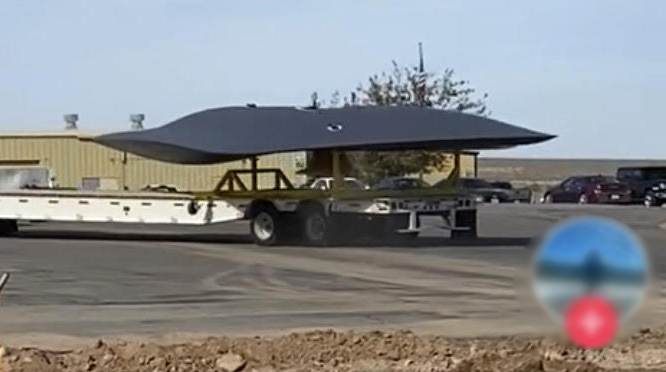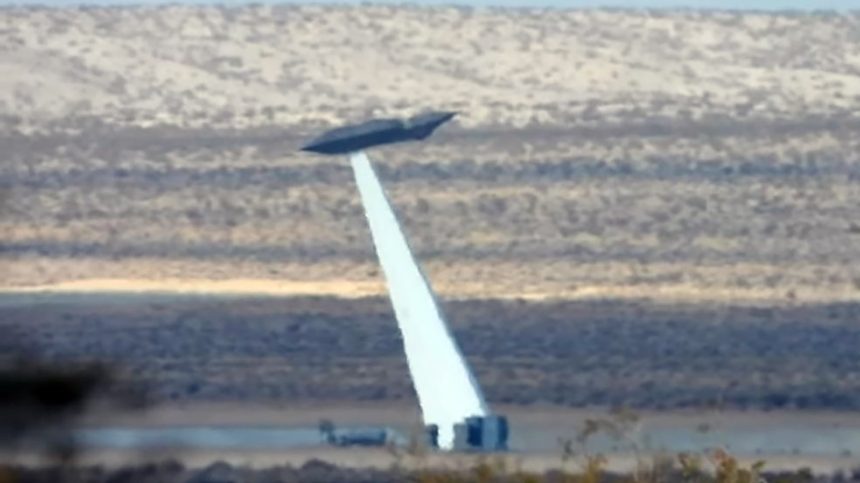A YouTube video posted by the account Uncanny Expeditions appears to show a previously unseen object undergoing testing at Lockheed Martin’s Helendale Radar Cross Section (RCS) Test Range in California’s Mojave Desert.
The footage, filmed from a distance, shows what appears to be a dark, diamond- or manta-shaped structure being mounted on a pole and moved during testing activities at the range. The object is seen in several sequences from different angles and lighting conditions. In one frame, a distinct blue area can be spotted on its upper surface. While the overall shape resembles a flying wing or blended-body configuration typical of stealth aircraft, its proportions and details do not match any known airframe.
An unidentified aircraft is undergoing testing at Lockheed Martin’s Helendale Radar Cross Section (RCS) Test Range in Southern California. pic.twitter.com/YiTCj7gEtz
— OSINTWarfare (@OSINTWarfare) October 3, 2025
This is not the first time that a mysterious shape has been observed at Helendale. In 2021, we reported on another unidentified article seen at the same site (read that story here).

However, the new object appears to be entirely different both in shape and size. The shape seen in the latest footage might represent a radar-test article, a fuselage section, an inlet, or a modular component designed to evaluate radar reflectivity of specific surfaces or angles. From a certain angle, the object resembles a “chunk” of an F-35 fuselage, mounted upside down.
Someone also noticed similarities between the test article and the Boeing Bird of Prey, which has often been mentioned in discussions about the F-47.
11 September 1996. First flight of the Boeing Bird of Prey. American black project aircraft. It developed technology and materials which would later be used on Boeing’s X-45 unmanned combat air vehicle. Missing screws on the horizontal stabilizer led to structural failure. pic.twitter.com/CtunyHoZXk
— Ron Eisele (@ron_eisele) September 10, 2025
Located northwest of Victorville, the Helendale RCS Range is one of Lockheed Martin’s key sites for radar-signature testing. Operated by the company’s legendary Skunk Works division, the facility includes several test pylons, radar arrays, and control stations that allow engineers to measure how experimental configurations scatter or absorb radar energy. Test items are often mounted on a pylon designed to minimize reflections and can be rotated or elevated for precise data collection.
Indeed, aircraft or test articles at radar cross section facilities around the world are often mounted upside down, a configuration that might look unusual but serves a specific technical purpose. Mounting the object inverted helps minimize reflections from the support pylon and the ground, providing a cleaner radar signature. It also allows engineers to simulate how an aircraft would appear to radar systems positioned below it, such as ground-based air defense radars, without requiring complex antenna setups or underground installations. Since these tests focus purely on radar behavior rather than aerodynamics, the orientation of the model does not affect the validity of the measurements.
Given that the object was seen being moved in broad daylight, it is unlikely to represent anything classified. Sensitive prototypes or production-representative stealth platforms are normally transported under cover or tested only at night to avoid exposure. Moreover, it’s safe to believe the presence of a cameraman was known to the range personnel, that could cancel tests when a spotter is reported to be in proximity (as done at Area 51). More likely, this is a non-flying test article, a calibration model, or a section used for RCS validation and materials testing, part of the continuous, largely unseen research feeding into next-generation programs. Whatever the case, it’s certainly something intriguing. The video is worth watching also because it shows the pole being retracted after the testing has been completed.
The appearance of the footage and related screenshots on social media immediately reignited the debate about OPSEC, leaks of sensitive imagery, and the recurring controversy between those who view such observations as potential espionage and those who point out that no laws are being broken when filming from public land.
It literally isn’t, fyi. Everything like this that I capture is done from public property, as I make clear in the video that these stills were lifted from. https://t.co/L956q3dOwW
— Uncanny Expeditions (@uncannyex) October 3, 2025
Anyway, as already noted, it is very likely that the presence of the observer was known to those operating the range. In fact, a Reaper drone even circled overhead at one point. Had the activity been considered classified or restricted, the individual would almost certainly have been approached or asked to leave the area.









